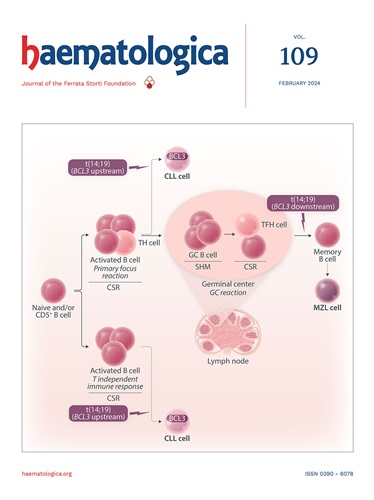CD6 expression is an independent predictor of time to first treatment in chronic lymphocytic leukemia.
IF 8.2
1区 医学
Q1 HEMATOLOGY
引用次数: 0
Abstract
CD6 is a lymphocytic receptor expressed by all T cells and a subset of B and NK cells. It physically associates with the antigen-specific clonotypic receptor of T (TCR) cells, where it modulates the activation and differentiation signals delivered along lymphocyte development and upon peripheral antigen recognition. CD6 is also expressed in some B cell malignancies (e.g., chronic lymphocytic leukemia, CLL), though its biological role and clinical performance is largely unknown. To this end, we have evaluated the potential impact of CD6 differential expression in a CLL patient cohort. 270 CLL patient histories from the CLL-ES project with available RNA-Seq data have been analysed. High CD6 expression was found to be associated with mutated IGHV status and predictive of longer time to first treatment in a uni- and multivariable model (10-year probability of receiving treatment was 33 vs. 55 % in CD6hi and CD6lo groups, respectively, P = 0.0003) along with the lymphocyte count and the CLL International Prognostic Index. Further gene set enrichment analyses (GSEA) showed association of high CD6 expression with downregulation of MYC-regulated, mitotic spindle-related and RNA splicing-associated genes, all positively related to cancer progression. Interestingly, CD38, a widely studied adverse prognostic marker in CLL, was significantly downregulated in the CD6 high group, in agreement with flow cytometry data. These results reinforce the notion that CD6 may play a pivotal role in neoplastic B cell biology and lay the ground to further explore CD6 expression in the context of CLL prognoses.CD6表达是慢性淋巴细胞白血病首次治疗时间的独立预测因子。
CD6是一种淋巴细胞受体,由所有T细胞和B细胞和NK细胞亚群表达。它与T细胞的抗原特异性克隆型受体(TCR)物理相关,在那里它调节淋巴细胞发育和外周抗原识别过程中传递的激活和分化信号。CD6也在一些B细胞恶性肿瘤(如慢性淋巴细胞白血病,CLL)中表达,尽管其生物学作用和临床表现在很大程度上是未知的。为此,我们评估了CD6差异表达在CLL患者队列中的潜在影响。分析了来自CLL- es项目的270例CLL患者的病史和可用的RNA-Seq数据。在单变量和多变量模型中,高CD6表达被发现与突变的IGHV状态相关,并且预示着首次治疗的时间更长(CD6hi组和CD6lo组接受治疗的10年概率分别为33%和55%,P = 0.0003),以及淋巴细胞计数和CLL国际预后指数。进一步的基因集富集分析(GSEA)显示,CD6高表达与myc调控基因、有丝分裂纺锤体相关基因和RNA剪接相关基因的下调相关,这些基因都与癌症进展呈正相关。有趣的是,CD38(一种被广泛研究的CLL不良预后标志物)在CD6高水平组中显著下调,这与流式细胞术数据一致。这些结果强化了CD6可能在肿瘤B细胞生物学中发挥关键作用的概念,并为进一步探索CD6在CLL预后中的表达奠定了基础。
本文章由计算机程序翻译,如有差异,请以英文原文为准。
求助全文
约1分钟内获得全文
求助全文
来源期刊

Haematologica
医学-血液学
CiteScore
14.10
自引率
2.00%
发文量
349
审稿时长
3-6 weeks
期刊介绍:
Haematologica is a journal that publishes articles within the broad field of hematology. It reports on novel findings in basic, clinical, and translational research.
Scope:
The scope of the journal includes reporting novel research results that:
Have a significant impact on understanding normal hematology or the development of hematological diseases.
Are likely to bring important changes to the diagnosis or treatment of hematological diseases.
 求助内容:
求助内容: 应助结果提醒方式:
应助结果提醒方式:


